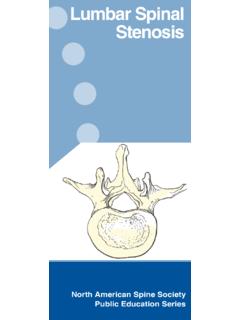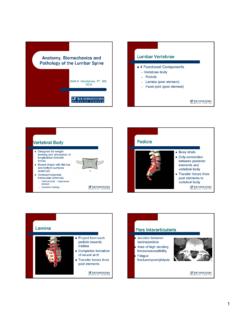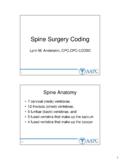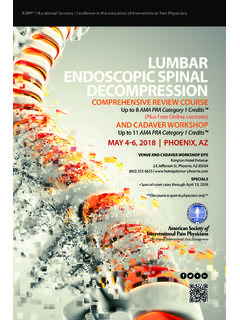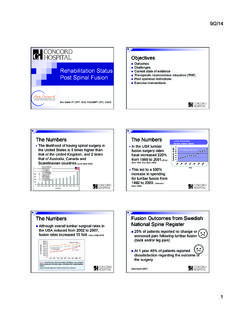Transcription of Fact Sheet: Interlaminar Lumbar Instrumented …
1 fact sheet : Interlaminar Lumbar Instrumented fusion (ILIF ) . Treating Stenosis with Decompression and Instrumented fusion Lumbar spinal stenosis (LSS) is the most common reason for back surgery in patients over 50. LSS leads to over 2 million doctor visits each year. The most common surgical treatment for LSS is a procedure called a decompression, which involves removing bone or ligaments that are pressing on the spinal cord and/or nerves. There are several different types of decompression procedures. The most common procedure used to treat LSS is called a laminectomy.
2 A laminectomy involves removing the spinous processes and the lamina to create a window above the spinal canal to relieve stenosis. This process requires the removal and/or disruption of the supporting ligaments, muscles, and bones that stabilize the spine. Traditional decompression procedures such as a laminectomy can destabilize the spine, so surgeons will often create a bridge of bone across the segment of the spine where the decompression was performed. This procedure, commonly referred to as a fusion , involves placing bone graft along both sides of the spine, followed by inserting screws and rods into the spine for stabilization.
3 There can be disadvantages associated with this traditional surgical treatment for stenosis. Surgeons may feel that a decompression procedure alone may create instability (which can create pain); however, a fusion with screws and rods may be too extensive and unnecessary. Other surgeons are concerned that scar tissue (fibrous growth) can occur at the window above the spinal cord following a laminectomy, resulting in pressure on the spinal cord and/or nerves. This is comparable to traditional pedicle screw fixation in flexion-extension and axial rotation.
4 This fact sheet is designed to inform you about the Interlaminar Lumbar Instrumented fusion (ILIF ) surgical procedure. It is not meant to replace any personal conversations that you might wish to have with your physician or other members of your healthcare team. This fact sheet is intended to answer some of your questions and serve as a stimulus for you to ask appropriate questions about the surgery. About Interlaminar Lumbar Instrumented fusion (ILIF) Surgery ILIF is a new treatment alternative. The ILIF procedure was developed to overcome the potential shortcomings of standard LSS.
5 Treatments using a minimally disruptive surgical technique. ILIF benefits include: ILIF minimizes destabilization of the spine ILIF involves a minimally disruptive decompression procedure called a laminotomy, which involves temporary distraction (opening up). of the space between the spinous processes, and careful removal of only small sections of bone to relieve the pressure on the spinal cord and nerves. fact sheet : Interlaminar Lumbar Instrumented fusion (ILIF ) . About Interlaminar Lumbar Instrumented fusion (ILIF) Surgery (Contd.)
6 ILIF utilizes a uniquely designed interspinous spacer to provide distraction, decompression, and fusion A precision-machined allograft (donor) bone is placed between the spinous processes to accomplish the following: Permanently distract (open up) areas that are pressing on the spinal cord and/or nerves. This is known as indirect decompression. Promote a fusion (growth and connection of two bones) between the spinous processes to provide long-term spine stabilization. Provide a protective cover for the spinal cord to help prevent scar tissue from pressing on the spinal cord and/or nerves.
7 ILIF utilizes a minimally disruptive stabilization device A small plate is attached to both spinous processes to stabilize the segment of the spine and promote fusion , eliminating the need for more extensive surgery. Biomechanical testing indicates the plate is comparable to traditional pedicle screw fixation. ILIF Patient Benefits Reduced operative time Traditional procedures can take 1-2 hours to perform, the ILIF procedure can be successfully completed in as little as one hour or less, reducing the amount of anesthesia time.
8 Reduced blood loss and minimal scarring The small 2-inch midline incision over the spinous processes results in much less trauma to the affected area, as compared to other traditional Instrumented fusions. Reduced post operative pain The ILIF procedure does not significantly disrupt the supporting ligaments, muscles, and bones of the back, so patients are usually walking the same day. Reduced hospital stay ILIF may require only an overnight stay in the hospital, compared to several days of immobility and hospitalization typical of traditional Instrumented fusion approaches.
9 Rapid return to normal activity Patients are usually walking the same day after surgery and recovery is typically around 4 weeks, compared to 3 months or more. Patient Complications We want you to understand all the associated risks of surgery and the potential complications that can result. These complications may include, but are not limited to, the following: Fracture of spinous process Allergic reaction Mechanical failure of the spinous process plate fact sheet : Interlaminar Lumbar Instrumented fusion (ILIF ) . Movement of the allograft spacer out of proper position Non- fusion (known as pseudoarthrosis ILIF Contraindications and Precautions We want you to understand all of the contraindications and precautions associated with the ILIF procedure.)
10 These contraindications and precautions may include, but are not limited to, the following: The Affix II spinous process plate is contraindicated for the use as a standalone device Severe Osteoporosis L5-S1 can be performed only if S1 spinous process is prominent Degenerative spondylolisthesis > grade 1. ILIF Precautions Severe Osteoporosis L5-S1 can be perfomed only if S1 spinous process is prominent Degenerative spondylolisthesis >grade 1. Since medical care is tailored to fit individual needs, not all information presented here will apply to your treatment or its outcome.

